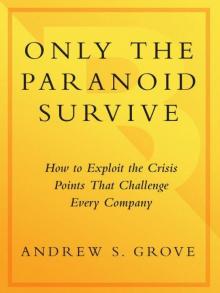- Home
- Andrew S. Grove
Only the Paranoid Survive Page 19
Only the Paranoid Survive Read online
Page 19
Chapter 7: Let Chaos Reign
“the sequence of emotions associated with grief …”: Elisabeth Kubler-Ross, On Death and Dying (New York: Macmillan, 1969).
“replacement of corporate heads …”: “‘In many cases, the emotional ties of the career CEO are just too strong,’ says Ferdinand Nadherny, vice-chairman of Russell Reynolds Associates, the nation’s largest executive recruiting firm.… [W]ith the recession creaming Tenneco’s 1991 results after years of erratic earnings, the board decided it was time to push aside the proud chief [James L. Ketelsen]. ‘[Michael H.] Walsh came with a clean perspective,’ explains one director. ‘He wasn’t weighed down by the politics of the past.’” “Tough Times, Tough Bosses,” Business Week, November 25, 1991, pp. 174–75.
“Strategic Dissonance”: For further discussion of this phenomenon, see Robert A. Burgelman and Andrew S. Grove, “Strategic Dissonance,” California Management Review, Vol. 38, No. 2, Winter 1996, pp. 1–20. I also make a parallel to the concept of cognitive dissonance: “New events may happen or new events may become known to a person, creating at least a momentary dissonance with existing knowledge, opinion, or cognition concerning behavior.… What, then, are the circumstances that make it difficult for the person to change his actions? 1. The change may be painful or involve loss.… 2. The present behavior may be otherwise satisfying.… 3. Making the change may simply not be possible.” Leon Festinger, A Theory of Cognitive Dissonance. (Evanston, IL: Row, Peterson and Company, 1957), pp. 4, 25–27.
“Compaq’s board of directors …”: “[A]fter weeks of high-level wrangling aimed at pulling the company out of a six-month decline in revenues, profits, and market share … [Compaq Chairman Benjamin M.] Rosen stepped in.” “Compaq’s New Boss Doesn’t Even Have Time to Wince,” Business Week, November 11, 1991, p. 41.
“importance of scale and scope …”: In his book, Scale and Scope (Cambridge, MA: Belknap Press, 1990), Harvard Business School Professor Alfred D. Chandler showed that many industries adapt to a model in which scale and scope end up being key. These historical examples helped us understand what we needed to do.
Chapter 8: Rein in Chaos
Lotus in 1985: “By leveraging Lotus’ position as a leading supplier of application software, we are continuing to develop a rich line of companion and complementary products.” Lotus 1985 Annual Report, p. 11.
Lotus in 1991: “It’s tempting to describe 1991 as a year of transition at Lotus.… But our customers’ world—and the world of individual users—now opens up onto a broader horizon. In this wider world, users are linked by networks and networked applications, and they share computing resources, information and work itself. [I]n Notes, we have the ground-breaking collaborative computing product that is changing the way companies do business.” Lotus 1991 Annual Report, pp. 2, 4, 5.
“Drucker suggests …”: Nineteenth-century French economist J. B. Say quoted in Peter Drucker’s Innovation and Entrepreneurship: Practice and Principles: “An entrepreneur is one who shifts resources from areas of low productivity and yield to areas of higher productivity and yield.” Op. cit.
early movers: see Gary Hamel and C. K. Prahalad, “Competing for the Future,” Harvard Business Review, July-August 1994, pp. 122–28.
“Put all of your eggs …”: “Behold, the fool saith, Put not all thine eggs in the one basket’—which is but a manner of saying, ‘Scatter your money and your attention’; but the wise man saith, ‘Put all your eggs in one basket and WATCH THAT BASKET.’” Mark Twain, Puddin’ head Wilson, (New York: Penguin Books, 1986), p. 163. First published in 1894.
“Hewlett-Packard decided …”: “Intel Corp. and Hewlett-Packard Co. shook the core of the computer industry last week when they announced a broad partnership to develop a new generation of microprocessor technology.” “Intel-HP Agreement Alters CPU Landscape,” PC Week, June 13, 1994, p. 1.
Dr. Wang’s vision: “An Wang was more than just a technical wizard. From the beginning, he thrived on keeping his hands in all aspects of the business, and the management system was perfectly designed to fit his voracious eclectic intellect. ‘The Doctor had a whim of iron. He was into everything. He would come into the engineering department, head to the blackboard of a first-level engineer and sketch out what he wanted,’ says a former engineer. ‘What Dr. Wang wanted then became the design.’” “The Fall of the House of Wang,” Business Month, February 1990, p. 24.
Wang in bankruptcy: “After peaking at $3 billion in revenue in 1988, Wang hit hard times as the PC industry advanced and started to cut into word processors.… ‘They completely misunderstood the PC industry and it cost them greatly,’ [said Stephen Smith, an analyst with Paine Webber, Inc.].” “Wang Files for Chapter 11, Plans to Let Go 5,000,” Computer Reseller News, August 24, 1992, p. 10
“a powerful, adaptive organization …”: For studies on this subject, see Robert A. Burgelman, “Intraorganizational Ecology of Strategy-making and Organizational Adaptation: Theory and Field Research,” Organization Science, Vol. 2, No. 3, August 1991. Also ibid., “Fading Memories: A Process Theory of Strategic Business Exit in Dynamic Environments, “Administrative Science Quarterly, No. 139, 1994.
“These debates are vigorous …”: “The real benefit … is to team up people with hands-on knowledge with those in positions of power to create the best solutions in the interest of both.” Andrew S. Grove, “My Turn: Breaking the Chains of Command,” Newsweek, October 3, 1983, p. 23.
“supporting the decision …”: “An organization does not live by its members agreeing with one another at all times on everything. It lives instead by people committing to support the decisions and the moves of the business.” Andrew S. Grove, High Output Management (New York: Random House, 1983), p. 91.
Hewlett-Packard: Hewlett-Packard 1994 Annual Report, p. 44.
AT&T and regional Bell companies’ market valuation: In December 1983, following the breakup, AT&T and the RBOCs had an approximate market valuation of $60 billion. Capital International Perspective (Capital International S.A., Geneva, Switzerland), January 1984, pp. 330–32. In 1995, their market value was approximately $240 billion. The Red Herring, September 1995, pp. 110, 112.
Chapter 9; The Internet: Signal or Noise? Threat or Promise?
“the stock skyrocketed …”: Netscape’s initial offering price on August 9, 1995, was $28 a share. It reached a high that day of $74 and subsequently peaked at $174 on December 6, 1995. Bloomburg Business News.
“creating a dramatized confrontation …”: “‘There are gales of creative destruction blowing through every corner of the information technology industry, and the source of that wind is the Internet,’ says Paul Saffo, a consultant and research fellow at the Institute for the Future in Menlo Park, California.” “Whose Internet Is It Anyway?” Fortune, December 11, 1995, p. 121.
For a more detailed history of the Internet, see Joshua Ed-dings, How the Internet Works (San Francisco: Ziff Davis Press, 1994).
“impact the telecommunications industry …”: “Personal communication over the Internet will overtake telecommunications in five to six years, and telephone operators have the biggest interest in getting into the online business.… The importance of the telephone in personal communications will diminish just like the fax has replaced the telex.” Reuters, February 1, 1996.
“impact on the software industry …”: “From tiny one-person shops to start-ups staffed by prominent Silicon Valley executives, the Net is teeming with new Web software companies. Most wouldn’t have a prayer in the conventional software market. But the Net represents a green field where no software maker dominates.” “The Software Revolution: The Internet Changes Everything,” Business Week, December 4, 1995, p. 82. And: “Currently, you have to pay money up front to distribute software through either conventional retail channels or through the large distributors that sell into corporations. On the Internet you don’t need these intermediate distribution mechanisms. So we see this potential for low-cost distributio
n of any kind of intellectual property—whether it be software, or pictures, or movies, or CDs, or anything that can be represented as bits—as one of the most revolutionary aspects of the Internet.” Interview with Jim Clark, The Red Herring, November, 1995, p. 70.
“won’t that siphon off business …”: “In the computer industry, there’s never been a company that’s led the way in two successive eras. So really, what Microsoft as a company, or Paul and I as individuals, are trying to do is defy history and actually take our leadership from the PC era into this new communications era. The odds are against us, and that’s what makes it so much fun and challenging.” Bill Gates quoted in “Bill Gates and Paul Allen Talk,” Fortune, October 2, 1995, p. 82.
“even advertisers are joining in …”: “Hachette Filipacchi said it has just signed a new media commitment with … General Motors.” “Hachette Entangles GM in Web for ‘96,” Wallstreet Journal, November 30, 1995, p. B6.
“worldwide spending on advertising …”: 1995 estimated global spending on advertising was $345.7 billion. Standard and Poor’s Industry Surveys, October 1995, Vol. 2, New York, p. M15.
“Internet appliances”: “The device promises to offer the most popular functions of a personal computer, such as sending electronic mail, surfing the Internet and word processing, at a fraction of the cost. There are limitations, however: It’s less powerful than a PC, and has no slots to play your own CD-ROMs or software.” “Ellison’s ‘Magic Box,’” San Francisco Chronicle, November 16, 1995, p. B1. Also, “The argument is that the day of the desktop application—and therefore the OS—ends when applications are stored and distributed over the Net.… Such technology provoked Upside magazine to gush that the Web is a ‘whole software standard that makes the current software industry obsolete’” “Dubious Extinction,” PC Week Inside, November 13, 1995, p. A14.
A CURRENCY BOOK
PUBLISHED BY DOUBLEDAY
a division of Random House, Inc.
1540 Broadway, New York, New York 10036
CURRENCY and DOUBLEDAY are trademarks of Doubleday, a division of Random House, Inc.
Only the Paranoid Survive was originally published in hardcover by Currency, a division of Bantam Doubleday Dell Publishing Group, Inc., in 1996.
Third-party trademarks and brands are the property of their respective owners.
The Library of Congress has cataloged the hardcover edition of this book as follows:
Grove, Andrew S.
Only the paranoid survive: how to exploit the crisis points that challenge every
company / Andrew S. Grove—1st ed.
p. cm.
1. Organizational change. 2. Strategic planning.
3. Technological innovations—Economic aspects. I. Title.
HD58.8.G765 1996
658.4′06—dc20 96-13509
eISBN: 978-0-307-57497-8
Copyright © 1996, 1999 by Andrew S. Grove
All Rights Reserved
v3.0

 Only the Paranoid Survive
Only the Paranoid Survive Swimming Across: A Memoir
Swimming Across: A Memoir